|
The San Joaquin Valley Air Pollution Control
District is made up of eight counties in
California’s Central Valley: San Joaquin,
Stanislaus, Merced, Madera, Fresno, Kings, Tulare and
the San Joaquin Valley Air Basin portion of Kern.
The Valley Air District is governed by an fifteen member Governing Board consisting of representatives from the Board of Supervisors of all eight counties, one Health and Science member, appointed by the Governor, one Physician, appointed by the Governor and five Valley city representatives.
|
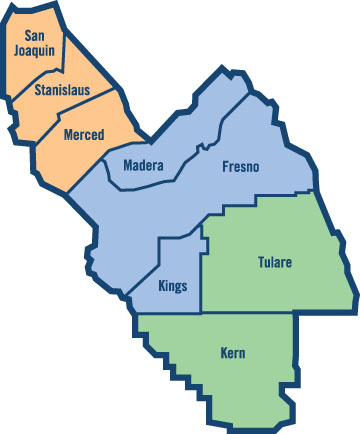 |
General PowerPoint on San Joaquin Valley Air Quality Issues
The Air District’s Mission
The San Joaquin Valley Air District is a public health agency whose mission is to improve the health and quality of life for all Valley residents through efficient, effective and entrepreneurial air quality management strategies. Our Core Values have been designed to ensure that our mission is accomplished through commonsense, feasible measures that are based on sound science.
The Air District’s Vision
Healthful air that meets or exceeds air quality standards for all Valley residents. The District is a leader
in air-pollution control. Valley residents take pride in our collective efforts to continuously improve air
quality.
Back to Top
Core Values
Protection of Public Health – The District shall continue to strive to protect the health of Valley residents through efforts to meet health-based state and federal ambient air-quality standards, based on science and prioritized where possible using health-risk reduction strategies.
Active and Effective Air Pollution Control Efforts while Seeking to Improve the Valley’s Economic Prosperity and Grow Opportunities for All Valley Residents
– District staff shall work diligently to adopt and fully implement cost-effective air pollution-control measures, provide meaningful incentives for reducing emissions, and develop creative alternatives for achieving emissions reductions.
Outstanding Customer Service – District staff shall work to provide excellent customer service for stakeholders
in activities including: rule and plan development; permitting and emissions inventory functions;
compliance activities; financial and grant-funding transactions; and responses to public complaints and
inquiries.
Ingenuity and innovation - The District values innovation and ingenuity in meeting the challenges we
face. Examples of this spirit of innovation include developing programs that provide new incentives for
emissions reductions, and providing alternate compliance strategies that supplement traditional regulatory
efforts and generate more emissions reductions than could otherwise be reasonably obtained.
Accountability to the public – The District serves, and is ultimately accountable to, the people of the Valley
for the wise and appropriate use of public resources, and for accomplishing the District’s mission with
integrity and honesty.
Open and transparent public processes – The District shall continue to provide meaningful opportunities
for public input and be responsive to all public inquiries.
Recognition of the uniqueness of the San Joaquin Valley – The Valley’s meteorology, topography and economy
differ significantly from those in other jurisdictions. Although it is valuable to review and evaluate
efforts of other agencies, we must consistently look for solutions that fully consider the Valley’s unique
needs.
Continuous improvement –The District works to continually improve its internal operations and processes,
and strives to streamline District operations through optimally utilizing information technology and human
resources.
Effective and efficient use of public funds – The District shall continually strive to efficiently use all resources
and to minimize costs associated with District functions.
Respect for the Opinions and Interest of All Valley Residents
– The District shall respect the interests and opinions of all Valley residents and fully consider these opinions, seeking collaboration with federal, state, and local agencies, agriculture, businesses, community groups and residents in carrying out the District’s mission.
Robust Public Outreach and Education on Valley Air Quality Progress and Continuing Air Quality Efforts
– As we move forward in achieving our mission, the District shall continue its ongoing efforts to educate the public about air quality, and the significant clean air investments and air quality progress that have been made in the Valley.
Back to Top
STAR Culture
The District takes great pride in its STAR work culture which promotes excellent customer service, positive staff morale, outstanding attitude, and exceptionally high level of productivity and innovation.
Back to Top
The Jurisdiction Puzzle
Federal and state laws require emission control measures in areas where air pollution exceeds standards.
The San Joaquin Valley is one of these areas. With a variety of state and federal agencies implementing
air pollution reduction programs, it can be difficult to understand the mission and jurisdiction of each
organization.
The federal government, primarily through the Environmental Protection Agency, sets standards, oversees
state and local actions, and implements programs for toxic air pollutants, heavy-duty trucks, locomotives,
ships, aircraft, off-road diesel equipment, and some types of industrial equipment.
State government, through the Air Resources Board and Bureau of Automotive Repair, sets more stringent
state standards, oversees local actions, and implements programs for motor vehicle emissions,
fuels, and smog checks.
Local air pollution control districts, such as the San Joaquin Valley Air Pollution Control District (Valley
Air District), develop plans and implement control measures in their areas. These controls primarily
affect stationary sources such as factories and plants. Local air districts also conduct public education
and outreach efforts such as the Valley Air District’s
Healthy Air Living
, Wood Burning, and
Smoking Vehicle
voluntary programs.
Local cities and counties are responsible for implementing air friendly community planning that promotes pedestrian traffic, commute alternatives and cleaner transit fleets.
While their jurisdiction and specific programs may vary, all of these organizations share a common goal: to work cooperatively in establishing comprehensive air quality control programs to benefit all California residents.
Back to Top
Where the
District Gets its Funding
The revenue to fund the District’s annual operating budget comes from the following three sources: Permit fees paid annually by applicable businesses operating within the District.
Motor vehicle registration fees generated by a $19 surcharge fee for every vehicle registered within the
District. A part of these fees are used for the internal operations of the District and a portion is distributed
to qualified applicants for programs intended to reduce vehicle emissions.
| The District receives federal and state grants annually from the California Air Resources Board and the United States Environmental Protection Agency.
The chart (at right) illustrates the approximate breakdown of the three revenue sources by percentage: |
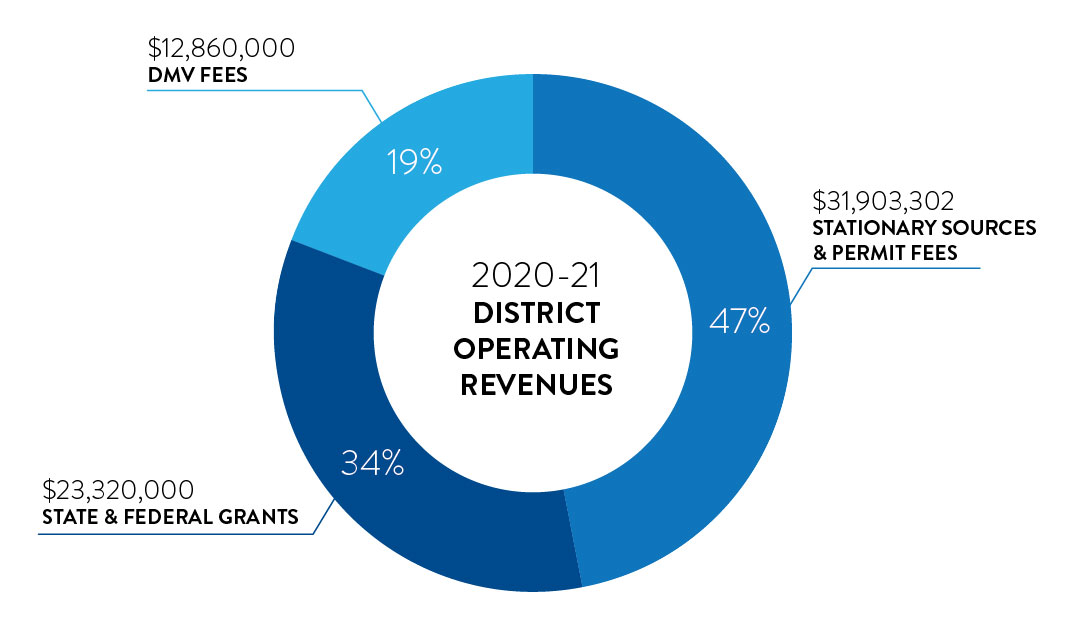 |
Back to Top
Making Progress
Air pollution within the District comes from a variety of sources. These
include industrial facilities, vehicles and consumer products. The pie chart below illustrates the sources
of ozone components and their levels.
Sources of Smog-Forming Emissions
San Joaquin Valley, 2019
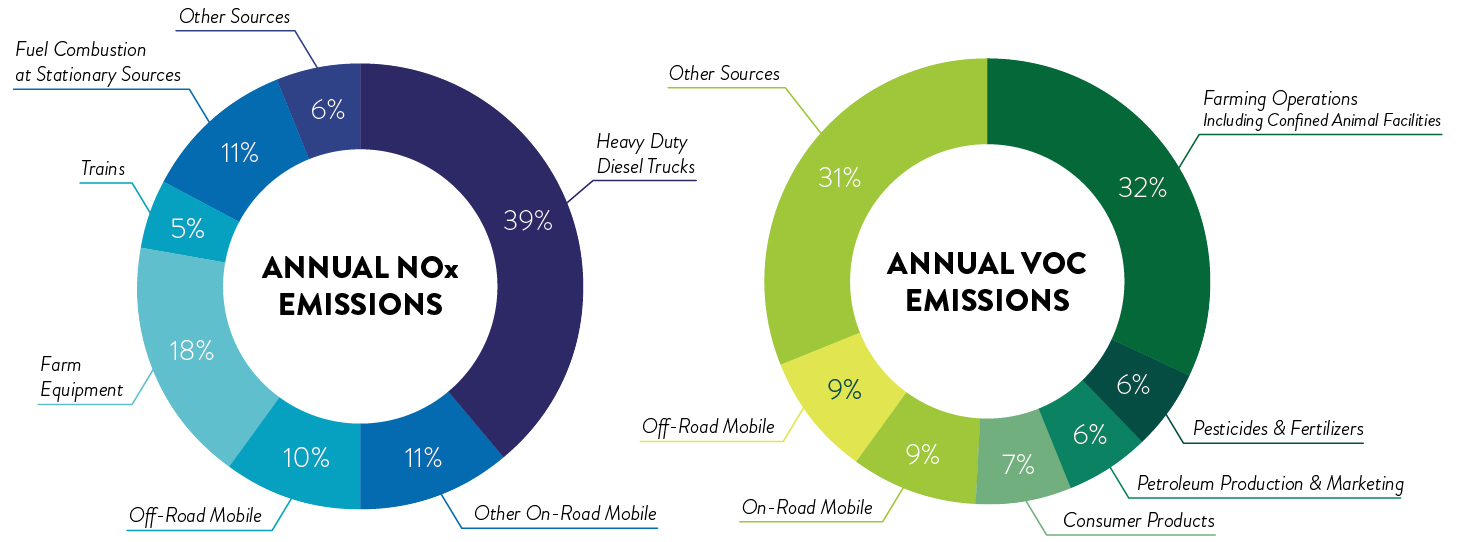
Emissions of reactive organic gases and oxides of nitrogen
Estimated by California Air Resources Board
After billions of dollars of investment by Valley businesses, pioneering air quality regulations and consistent effort by Valley residents, the Valley air basin has made historic improvements in air quality.
Despite natural challenges such as the geography, topography and meteorology of the air basin, which create a low capacity for air pollution, the Valley has worked its way up from nonattainment to attainment of critical health standards. Air quality in the Los Angeles area is only marginally worse than the Valley’s although about 10 times more pollution is emitted in that region. The Bay Area’s air quality is much better than the Valley’s, even though about six times more pollution is released there.
Yet the Valley has reduced emissions at the same rate or better than other areas in California and set unparalleled achievement milestones in the process.
- In the 1990s, the Valley became the first air basin classified as “serious nonattainment” to come into attainment of health standards for coarse particulate matter (PM10).
- In 2013, for the first time in recorded history, the Valley had zero violations of the hourly ozone standard established under the federal Clean Air Act, down from 281 violations in 1996 and seven violations in 2012. This remarkable achievement makes the Valley the first air basin in the country to improve from a designation of “extreme” nonattainment to attainment of an air pollutant.
Emission reductions are required by federal and state mandates such as the Federal Clean Air Act amendments and the California Clean Air Act. Though effective air pollution control programs are still needed, past efforts have brought about a significant improvement in air quality (see below).
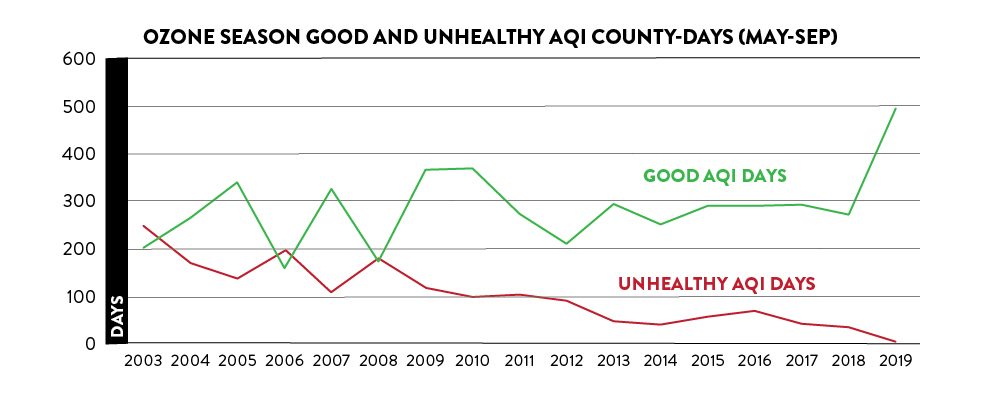
Since 2003, the number of “good” air quality index (AQI) days in each county has steadily improved, while the number of “unhealthy” days has decreased. After 2008, “good” days always outpaced “unhealthy” days, despite stagnant drought conditions and severe wildfires in the past decade. In 2019, the number of “good” county days reach the highest point in recorded air quality history, while the number of “unhealthy” days is the lowest ever.
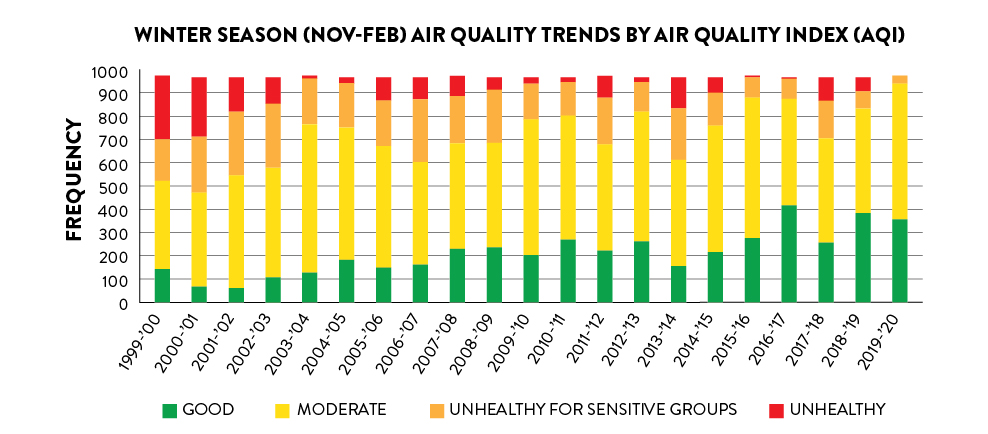
During the 2019-2020 winter season (November through February), the Valley continued to demonstrate significantly improved air quality. Despite experiencing one of the driest winter seasons on record, the Valley continued to progress towards attaining the federal PM2.5 standards. These continued improvements in air quality would not have been possible without the emissions reductions achieved under the District’s control strategy as well as the commitment from the Valley’s residents and businesses to reduce emissions in their daily activities.
|
|
Criteria Pollutants
federal standards |
|
Lead |
Attainment |
|
Nitrogen Dioxide |
Attainment |
|
Sulfur Dioxide |
Attainment |
|
Carbon Monoxide |
Attainment |
|
PM10 |
Attainment |
|
Ozone, 1-hr standard (revoked) |
Zero exceedances in 2013, in late 2013 requested EPA to designate Valley as in Attainment |
|
Ozone, 8-hr standard |
# of exceedances of 1997 standard reduced 61% since 1992
# of exceedances of 2008 standard reduced 43% since 1992
|
|
PM2.5 |
Zero exceedances of the 1997 24-hour PM2.5 standard of 65 µg/m3 during an entire calendar year for the first time in Valley history
Fewest exceedances of the 2006 24-hour PM2.5 standard of 35 µg/m3
Highest number of “Good” Air Quality Index (AQI) days across all of the District’s counties
Fewest number of “Unhealthy” AQI days across all counties
|
Back to Top
|